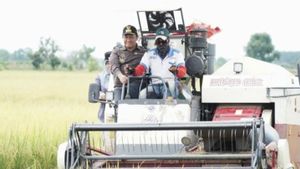
JAKARTA - Silver man gave birth. A viral photo shows a baby covered in gray screen printing paint mixed with cooking oil or soil. The issue of child labor in Indonesia has come to the fore again. This is nothing new. We remember that many years ago, an alternative rock band from England, Radiohead, highlighted the hard life of Indonesian children as workers.
Last weekend, a photo of a sleeping baby painted silver went viral. The baby was allegedly taken to beg in the Pamulang area, South Tangerang. Head of South Tangerang City Satpol PP Muksin Al Fachry explained that the baby's parents had been found. The silver baby and his mother were then taken to the South Tangerang Social Service.
"According to his mother, NK (21) the baby is ten months old. The baby does not yet have a birth certificate because he was not born in a hospital and it is impossible to make a certificate," Muksin told reporters on Sunday, September 26.
According to the mother's statement, the baby with the initials MFA is usually entrusted to his neighbour. The mother admitted that she knew her neighbor worked as a silver man but did not know that her baby was invited to become a silver man. Only then did the neighbor give NK Rp. 20 thousand to buy pampers and milk. "But indeed when he came home his body and hands and feet had silver paint on them."
Silver human population growth and government failure at the start of the pandemicThe National Commission for Child Protection (PA) noted that there were 189 silver human families in Jakarta. Some of these families involve children, even babies -- hundreds of them -- who are also made into silver men and invited to bust around to earn a living.
Not only in Jakarta. Silver human families were also found in a number of buffer zones for the capital, such as Depok and South Tangerang. In Depok there are 200 silver human families, including children, toddlers, and infants.
The chairman of Komnas PA Arist Merdeka Sirait said the silver human population was a new social problem. "They live on the streets, in cardboard houses, or under bridges," said Arist.
"The cases of babies in South Tangerang that are painted silver are a small part of a new phenomenon that always escapes the attention of the government, both central and regional," Arist, in a written statement.
According to Arist, the COVID-19 pandemic has encouraged more and more people to earn a living by becoming silver people. Arist also highlighted the actions of parents to make children as objects of work as a form of violence and dangerous.
"This is a form of violence against children, crimes against humanity, and degrading the dignity of children. This new social problem must be stopped and a solution or solution is sought," said Arist.
The growth of the silver human population due to the pandemic is realized by the Central Jakarta Social Service. “In the past, we could see that there was nothing like that. This means that this is a pandemic situation that affects the community's economy," said the Head of the Ngapuli Parangin Angin Sub-department, last November, as reported by Antara.

The Social Counseling Center of the Ministry of Social Affairs (Kemensos) said that the silver human phenomenon has existed since 2020. They appear in big cities in Indonesia. According to the Ministry of Social records, many of them previously worked as buskers. Others are those who originally worked in an office but were later laid off due to the pandemic.
Last February, the Central Statistics Agency (BPS) released data on the increase in the number of poor Indonesians due to the COVID-19 pandemic, reaching more than 2.7 million people. The increase, according to the researchers, was due to the pandemic policy that was not firm at the start. Bad news bonus, due to the indecision, the economic recovery is predicted to take a long time.
According to BPS records, the pandemic resulted in the breaking of Indonesia's record economic growth. Due to the pandemic, it is the first time the poverty rate has increased in the last three years. BPS data classifies the poor as those whose expenses are below IDR 460 thousand per person or IDR 2.2 million per family per month.
In September 2020, the number of poor people reached almost 28 million people or 10.19 percent of the total population. This figure is up almost one percent compared to September 2019. The Ministry of Finance (Kemenkeu) claims that social assistance through the National Economic Recovery Program (PEN) has restrained the growth of the poor.
Citing data from the World Bank, the Ministry of Finance said that without PEN, the poverty rate could reach 11.8 percent. "This means that the PEN program throughout 2020 is estimated to be able to save more than five million people from becoming new poor," said Head of Fiscal Policy at the Ministry of Finance Febrio Kacaribu, quoted by the BBC.
University of Indonesia economic researcher Teguh Dartanto explores the government's failure at the start of the pandemic with its long-term impact on population poverty. The Ministry of Finance's claim is true. But, "is this policy sustainable? No. It's called a painkiller (pain reliever). It only relieves. It's not a solution to the disease itself," said Teguh.
Child labor in IndonesiaIndonesia is one of the countries with a high rate of child labor. A fact that was even acknowledged by the Minister of Women's Empowerment and Child Protection (PPPA) I Gusti Ayu Bintang Darmawati. And the actual condition, according to Bintang Puspayoga - a more familiar greeting - is even more concerning.
"Until now it is still concerning and even more worrying after the arrival of the COVID-19 pandemic," he said in a webinar.
Based on Sakernas data in August 2020, it is known that 9 out of 100 residents aged 10-17 years (9.34 percent or 3.36 million) have been employed. Of that number, 1.17 million of them are children. The increase in child labor can be seen by comparing the 2019 data. Child labor in the 10-12 years and 13-14 age groups experienced the most significant increase.
The data also shows that there are more child laborers in rural areas than in urban areas, the percentage is 4.12 percent compared to 2.53 percent. Broken down by gender, there are more boys than girls, with a ratio of 3.34 percent and 3.16 percent.

"Nevertheless, the ILO mentions that there is a possibility that a lot of girls' work is unaccounted for because they do a lot of unpaid care, such as taking care of the household," said Bintang.
The issue of child labor is a serious problem because it threatens the fulfillment of children's rights. Child labor causes the risk of dropping out of school, neglecting, and pushing children into dangerous situations that threaten their maximum growth and development. According to data, in August, the majority of child workers aged 15-17 years or 73.72 percent were no longer in school.
In Indonesia, regulations regarding children who are employed are regulated in a number of rules. Article 88 of Law Number 35 of 2014 concerning Child Protection, for example, threatens a maximum of ten years in prison and/or a maximum fine of Rp. 200 million for every person who employs children.
On the other hand, Article 185 of Law Number 13 of 2003 concerning Manpower mandates a maximum prison sentence of four years and/or a maximum fine of Rp. 400 million for business actors who employ minors. However, the Manpower Law provides room for employers to legalize the use of child labor over the age of 12.
First, employers must obtain written permission from parents. Second, employers and parents are required to sign an agreement. Then, children can only work a maximum of three hours per day. Work can only be done during the day. Finally, children's work must not interfere with education, health, physical, social and mental.
Radiohead and the MTV Exit . campaign"Come on, everyone. Come on, wake up. Wake up, wake up!"
A woman screams while swinging her legs towards a group of children sleeping in a hallway. The scene on the screen is divided into two. Two stories that run parallel play. The left side shows the dark life of the children of shoe factory workers which they call "the lives of children in the east". Meanwhile, the right side shows the comfortable life that a boy gets in the western hemisphere.
Many believe the video depicts the dark conditions of children employed in Indonesia. A few years before the video, in 2002 to be exact, Indonesia was in the world's spotlight because of the case of child slavery in a shoe factory in Bandung, West Java. A number of theories about it are also reinforced by the comments of viewers in YouTube video uploads.
I'm the next act
Waiting in the wings
I'm an animal
Trapped in your hot car
I am all the days
That you choose to ignore
Thom Yorke's voice drifted, followed by a string of minor rhythms. Dark. Perfect. That was the first time, I, who was still in high school, was faced with a reality about children being employed. Exploited.
Thom Yorke is a musician who never keeps his political views to himself. Following Radiohead's footsteps is almost the same as tracing the footsteps of Thom Yorke's thoughts and his way of dealing with problems in the world.
In 2008, when MTV was contacted to take part in the MTV EXIT (End Exploitation and Trafficking) campaign, Thom Yorke was spontaneously enthusiastic. "It's great that MTV brought this up. Usually it's something I can only talk about with people who are considered 'extreme left wing' or whatever. So it's great because we don't have to be on either side (in politics) to see the wrongs in this. this issue," said Thom Yorke, quoted from MTV.com, Thursday, July 23.
This project is special. Radiohead and MTV teamed up with Oscar-winning cinematographer John Seale (The English Patient-1997). In the director's chair, Steve Rogers is directing. The project targets a big impact, namely the collective awareness of the world community about the dark reality of the fate of children who are forced to work. It is also hoped that this video will awaken many adult men and women that some of us may be undergoing some form of exploitation.
There is a reason why Radiohead chose the song All I Need from the album In Rainbows for this project. Reasons that Seale and Rogers translate very well. "That's the kind of image I have in my head," said Thom Yorke.
"Sometimes when you're walking down the High Street and you see (shoes) that are really cheap, you kind of think, 'Hmmm, how did they get that so cheap?' That moment of thinking touched me that the music (All I Need) would fit this issue. I thought it would be great," he added.
*Read other information about POVERTY or read other interesting articles from Yudhistira Mahabharata.
Other BERNASThe English, Chinese, Japanese, Arabic, and French versions are automatically generated by the AI. So there may still be inaccuracies in translating, please always see Indonesian as our main language. (system supported by DigitalSiber.id)









